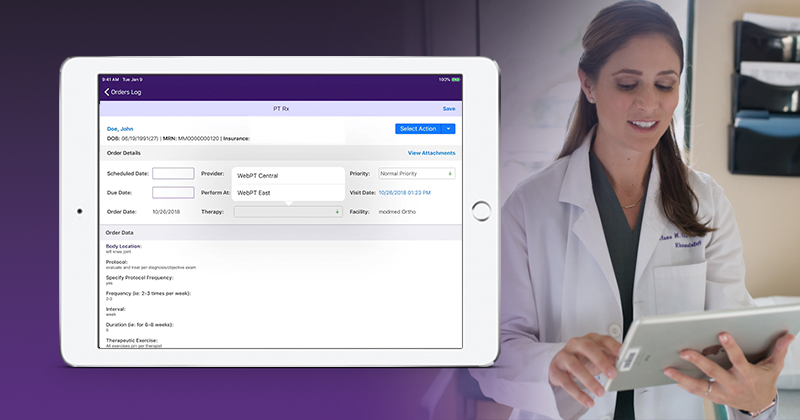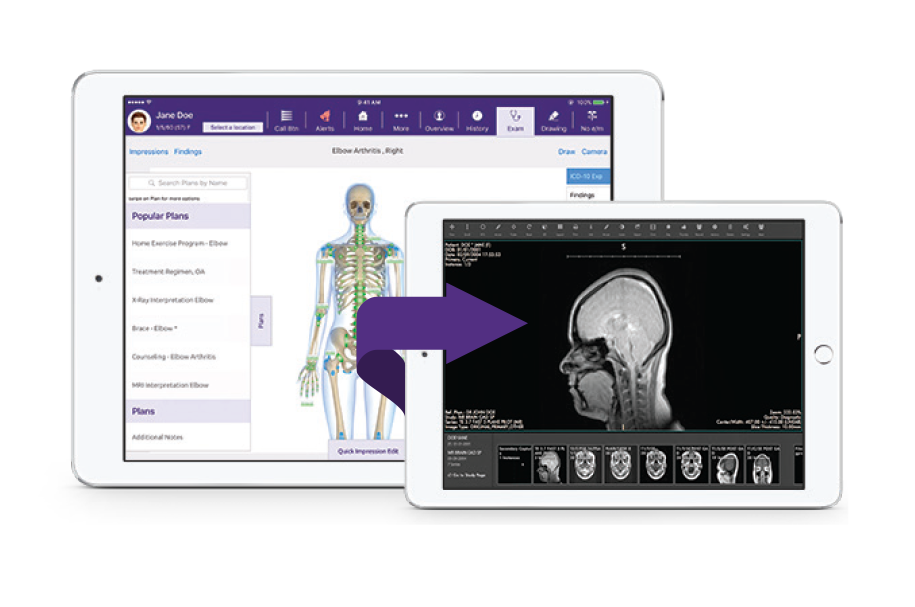How Can You Promote Interoperability in Your Orthopedic EMR?

Physical therapy and PACS imaging interfaces in EMA can help your orthopedic practice.
One of the most important features of an orthopedic electronic medical record (EMR) is interoperability, or how well it plays with other healthcare software or across different networks to share data. To deliver effective care, providers should be able to work together to create a comprehensive picture of each individual patient’s health. Additionally, with the transition to value-based care, the need for more interoperability is becoming increasingly essential to the financial side of your orthopedic practice.
An orthopedic EMR that promotes interoperability provides tools and interfaces that may help make running your orthopedic practice and treating patients easier and more efficient. Within the orthopedic continuum of care, imaging and physical therapy provide key opportunities to promote interoperability with your orthopedic EMR. Modernizing Medicine’s award-winning orthopedic EMR, EMA™, provides easy-to-use interfaces with PACS imaging and physical therapy software to help streamline your workflow and coordinate your patient care.
Physical Therapy EMR Interface
Physical therapy is an essential element of the overall orthopedic treatment algorithm. Orthopedic surgeons need to have open communication with the physical therapy team to help provide treatment and to help patients return to daily activities. To help streamline communication in orthopedic practices that offer in-house physical therapy and rehabilitation services, Modernizing Medicine and WebPT teamed up to build an interface between WebPT EMR and EMA. This two-way interface allows multiple members of a patient’s orthopedic care team — from the orthopedic surgeon to the physical therapist — to securely share information throughout the orthopedic continuum of care.
Orthopedic providers can easily order physical therapy during the flow of a patient exam and send the order electronically from EMA directly to the WebPT EMR. The electronic order from the orthopedic EMR, EMA, includes pertinent patient information such as demographics, insurance information and the full therapy order.
When the patient has completed physical therapy treatments, the rehabilitation team can send the therapy notes back to EMA, where the notes automatically attach to the patient’s chart. Additionally, the therapy charges, including CPT codes, seamlessly transfer into Modernizing Medicine’s Practice Management system to help streamline your orthopedic medical billing process.
The interface between EMA and WebPT helps reduce manual processes and redundancies for your staff, like printing and faxing orders and notes back and forth. Orders and therapy notes automatically save to the patient’s chart in EMA, helping to avoid manual documentation errors and centralize patient information. Additionally, WebPT and modmed® Orthopedics both provide analytical reporting, practice management tools and outcomes tracking. With these tools, you can save time for your staff and improve operational efficiencies between your orthopedic clinic and in-house physical therapy team.
PACS System Interface in Your Orthopedic EMR
 Like physical therapy, imaging makes for another essential component for orthopedic surgeons to appropriately diagnose issues and develop a suitable treatment plan. A PACS enabled orthopedic EMR can simplify the workflow in your clinic and save you time.
Like physical therapy, imaging makes for another essential component for orthopedic surgeons to appropriately diagnose issues and develop a suitable treatment plan. A PACS enabled orthopedic EMR can simplify the workflow in your clinic and save you time.
Typically, PACS systems work completely independent from the EMR system, with patient images being stored in a different location from the patient’s chart. When imaging is ordered, it can take hours to days to receive the imaging back. Then you have to log into multiple systems to view a patient’s medical history, visit notes and diagnostic imaging. This process can slow down your day and takes time away from seeing your patients.
With the Ambra Health PACS interface in EMA, orthopedic surgeons can directly connect EMA and their images from almost any PACS system. Electronic orders placed from the virtual exam room route to your imaging system. When the imaging is complete, the link to the study and any interpretation notes route back to EMA and attach to the patient’s chart. You can access the patient’s images from within EMA, without having to leave the exam room or log into a seperate desktop or workstation.
Ambra’s PACS and image management platform interface with EMA can handle all DICOM modalities including MR, CT, PET, CR, US and MG. Non-DICOM imaging can be stored side-by-side with DICOM for a holistic view of patient imaging. And like EMA, Ambra’s cloud-based and mobile PACS system allows you to access patient imaging in a web-based viewer on virtually any computer or tablet with an internet connection.
A bi-directional electronic interface that allows for easy image uploading and sharing with other providers can help orthopedic care teams reduce manual processes, reduce reliance on CDs and DVDs, speed up turn around time on imaging studies and create a better experience for their patients.
As healthcare software interoperability has become increasingly mandatory, you should look for solutions tailored to your orthopedic workflow. The physical therapy and PACS interfaces offered within EMA promote orthopedic-specific interoperability that can help you provide patient care more efficiently.
